
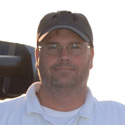
David Alberg joined the National Marine Sanctuary Program in the fall of 2005. As Sanctuary Superintendent for the Monitor National Marine Sanctuary, Mr. Alberg serves as the onsite manager for the sanctuary and as the primary point of contact between NOAA and The Mariners’ Museum in Newport News, Virginia which is conserving the thousands of artifacts recovered from the wreck of the USSMonitor. He has an extensive background in cultural resource management, museum work and exhibit development and has been involved in a number of high-profile museum projects. In 1992, Mr. Alberg began his museum career as the first curator for the Virginia Air and Space Center in Hampton Virginia and went on to serve as the Director of Exhibits and Collections for the U.S. Space & Rocket Center in Huntsville, AL. Most recently, he served as the Deputy Director for Nauticus in Norfolk, Virginia where he was instrumental in the expansion of the NOAA@Nauticus partnership.

John began his academic career in 2008 after earning a bachelor's degree in Biology from East Carolina University. Thereafter, he worked as the Assistant Diving Safety Officer at the North Carolina Aquarium in Roanoke Island and also as a recreational diving instructor and charter vessel divemaster. Returning to graduate school in 2009, John earned a Master's Degree in Maritime Studies from East Carolina University in 2012. Starting in 2010, John began working with the National Park Service's Submerged Resources Center as a student employee. Upon completion of his graduate degree, he transitioned into full time work with the National Park Service until taking a position at Thunder Bay National Marine Sanctuary in early 2015, where he currently works as a Maritime Archaeologist and Unit Diving Supervisor. John's participation in the Battle of the Atlantic Expedition began in 2008 and he has participated in various capacities throughout the years as a volunteer, graduate student, National Park Service partner, and National Marine Sanctuaries partner. His contributions mainly stemmed from his Master's Thesis research involving the KS-520 convoy action. Combining historical research and archaeological data, John conducted a naval battlefield reconstruction and survey which was integral to defining the survey area ultimately responsible for locating the remains of U-576 and Bluefields.
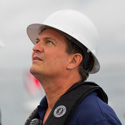
Robert Carmichael has a constant passion for underwater exploration and a knack for improving the functionality of mechanical devices. He learned how to build a recreational hookah system in 1980 as the first full-time employee of Brownie’s Third Lung, a job that inaugurated his love for diving. In the late 1980’s he began experimenting with technical mixed gas diving and was the enterprising force behind the development of what would become the Halcyon “PVR-BASC” rebreather. This rebreather helped revolutionize deep, technical diving and would lead to numerous world record cave dives. Over more than 15 years these and many other innovations were developed with Robert’s business partner and friend, Jarrod Jablonski, with whom he founded Halcyon Manufacturing in 1995. Robert continues to bring innovative solutions into a wide range of marine applications, building a team at Global Sub Dive which supports mixed gas supply and submersible support systems aboard the Baseline Explorer. Robert is proud to donate some of GSD's time and resources to the exploration and conservation efforts of Project Baseline worldwide.

Brandi Carrier wants to live in a world where everyone is a steward of our shared underwater cultural heritage. Brandi is a Registered Professional Archaeologist and scientific diver with more than fifteen years of experience in cultural resources management and an MA in Archaeology and Prehistory. She joined the Bureau of Ocean Energy Management in 2011 to provide regulatory support for the nation's development of offshore renewable energy. In her role as Archaeologist and Atlantic Regional Preservation Officer, Brandi has the opportunity to design and direct marine archaeological research to support this development. But Brandi’s real vision is one in which everyone everywhere can connect with their shared human heritage – without ownership or exclusivity – through archaeology. When Brandi isn’t working for her not-for-profit, running, or sailing, she’s usually hanging out with her border collie Mattie or cooking up a delicious paleo-friendly meal. She is most definitely, not ever, checking facebook.
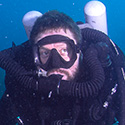
Tane Casserley is the Research Coordinator with the Monitor National Marine Sanctuary and the Deputy Line Office Diving Officer for the National Ocean Service. Tane specializes in 19th-century warships and deep-water archaeology. Tane holds a graduate certificate in maritime archaeology from the University of Hawaii and a master's degree from the Program in Maritime Studies at East Carolina University. He has led NOAA archaeological expeditions in the Florida Keys, the Great Lakes, California, the Northwestern Hawaiian Islands, Alaska, and the USS Monitor. He dove with the National Park Service on a sunken B-29 in Lake Mead, and was most recently part of the ongoing research to document the maritime landscape of the WWII Battle of the Atlantic off the coast of North Carolina. Tane's projects have used technical diving, remotely operated vehicles (ROVs), autonomous underwater vehicles (AUVs), and manned submersibles. Tane is a dive instructor and certified trimix and closed-circuit rebreather diver with the National Association of Underwater Instructors (NAUI), as well as the Nautical Archaeology Society Senior Tutor for NOAA's Office of National Marine Sanctuaries.

Jason Epp is a skilled robotics, sensor, and field technician at 2G Robotics with over five years of technician experience. Jason's background in electrical engineering and passion for marine technology have carried him around the world, operating 2G Robotics' equipment on customer deployments worldwide.

Jason Gillham is the founder and CEO of 2G Robotics with over 10 years of experience in the development of marine technology, the operation of marine robotics, and the processing and analysis of data from marine systems. Driven by the desire to disrupt antiquated inspection solutions, Jason and the team at 2G Robotics developed 3D laser scanning and imaging technologies for performing cost efficient, high precision inspections of underwater assets and environments.
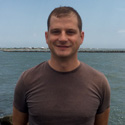
William Hoffman is an archaeologist with the Bureau of Ocean Energy Management, Office of Renewable Energy Programs. He received his undergraduate degree in archaeology from the George Washington University and his master's degree in anthropology from the Florida State University. He has been involved with the Battle of the Atlantic project since 2012. William also serves as the Atlantic Regional Diving Officer for BOEM’s Scientific Diving Program.
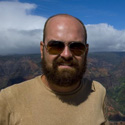
Hoyt is a maritime archaeologist with NOAA's Office of National Marine Sanctuaries. He specializes in archaeological recording of deep water shipwrecks. He has worked on several NOAA projects in the Thunder Bay, Florida Keys and Monitor National Marine Sanctuaries since 2001. In 2004, he was awarded the North American Rolex Scholarship through the Our World Underwater Scholarship Society. He has worked on underwater archaeology projects in the Great Lakes, Atlantic and Pacific Oceans, and several inland rivers. Joe is also an avid underwater photographer and technical diver, and has crewed documentary expeditions on BBC's Planet Earth and PBS. Since 2008 Hoyt has been the PI on a multifaceted wide area investigation of WWII era shipwrecks lost off the coast of North Carolina. Survey methodologies employed for these assessments are designed to cover the need for sound archaeological recording as well as address concerns relating to the management and long term monitoring of cultural resources. Hoyt holds an MA in Maritime History and Nautical Archaeology from East Carolina University.
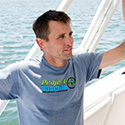
Todd has been diving since 1979 and cave diving since 1987. He has explored and mapped underwater caves in Florida, Turkey, Mexico, and China and studied the role of caves in controlling groundwater flow patterns for M.S. and Ph.D. university degrees. He is currently working with a team of researchers and explorers with the Florida Geological Survey and Global Underwater Explorers’ (GUE) Woodville Karst Plain Project to understand karstic groundwater flow to Wakulla Spring in North Florida. That work has included detailed underwater cave mapping, quantitative groundwater tracing, hydraulic metering of discrete cave passages, and the numerical simulation of conduit/matrix groundwater flow. He is one of the original founders of GUE, currently serves as GUE’s vice-president, and also leads a small consulting company, GeoHydros, that specializes in geological and groundwater modeling. He also serves on the Advisory Board for the Hydrogeology Consortium and the Florida Springs Institute, both non-profit organizations dedicated to the protection of Florida’s springs.
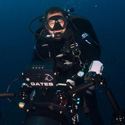
John McCord is the Associate Director of Public Education and Outreach at the UNC Coastal Studies Institute (UNC CSI). In addition, John runs UNC CSI’s Advanced Media and Visualization lab and specializes in high quality scientific photography and videography for research and education audiences. John has served as the primary videographer on the annual Battle of Atlantic Expeditions since 2008, documenting the ongoing project and creating a variety of education and outreach products including video documentaries, exhibits and web based learning tools.

Will Sassorossi is an avid diver and history buff who joined NOAA's Monitor National Marine Sanctuary staff in 2015 as a maritime archaeologist. A Master's graduate of East Carolina University's Maritime Studies Program, Will’s focus and thesis research involved three World War II era commercial vessels converted for military use sunk off the North Carolina coast, including YP-389. Will is not new to the sanctuary program, in 2013 and 2014, he worked with the sanctuary in various capacities assisting with the Battle of the Atlantic expeditions. A native of New Hampshire, Will relocated to the Hampton Roads area and has since taken on a wide variety of roles including Sanctuary Advisory Coordinator and Volunteer Coordinator at the Monitor National Marine Sanctuary.
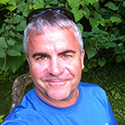
Drew has over 25 years’ experience in the GIS industry. After receiving his Master's Degree from Appalachian State University's Geography and Planning Department in 1991, he went to work at Intergraph Corp. in Huntsville, AL, as a Systems Engineer. In 1993 he accepted a position with ESRI in Boulder, Colorado as Instructor / Consultant, where he co-developed GIS training materials for the US Forest Service among other projects. In 1996, he founded AllPoints GIS, a training and consulting company focused on Natural Resource GIS applications. In 2001 Mr. Stephens formed The GIS Institute, a 501(c)(3) not-for-profit organization dedicated to facilitating GIS acquisition and implementation for humanitarian and conservation-related organizations that could otherwise not afford GIS tools needed to support their missions. Today, Mr. Stephens specializes in disaster response and natural resource work-flows and training, ArcGIS Server applications, Common Operational Picture “COP” mapping, and custom map viewer development.

Dr. Chris Taylor is an Ecologist with NOAAs National Centers for Coastal Ocean Science and leads the marine ecosystem acoustics group at the NOAA Beaufort Laboratory in North Carolina. His group develops advanced sampling techniques including underwater acoustics and optical methods to improve assessments for fish and their ocean habitats. For this project, Chris is leading the interpretation of ultra-high resolution seafloor imaging data from the ship, submersible and autonomous underwater vehicles (AUVs) that will provide an unprecedented digital model of the biological components of the habitat and fish that use both the battlefield and natural deep water reefs in the vicinity.